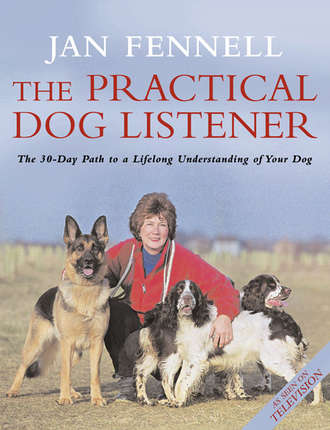
Полная версия
The Practical Dog Listener: The 30-Day Path to a Lifelong Understanding of Your Dog
A Question of Breeding
When I was given my first dog, a Border collie called Shane, there were relatively few breeds readily available to buy. How things have changed. Today, new owners face a bewildering choice of breeds, from exotic Oriental dogs like the Akita and the shih-tzu, to breeds that, until recently, were considered rare, like the Newfoundland or husky.
I am often asked whether particular breeds are more suitable for some people than others. My answer, in general, is that anyone can own any breed provided the dog fully understands its status within the domestic pack. A Yorkshire terrier that believes it is boss may not deliver as bad a bite as a Rottweiler or German shepherd under the same delusion; nonetheless, a bite is a bite. If a dog’s attitude is right, this problem will not arise so the breed of dog is immaterial, yet there are some general guidelines you should bear in mind.
If, for instance, you have a quiet, family lifestyle and are looking for a more relaxed companion rather than an active dog, you might be advised to take a breed that does not need as much exercise, something like a Tibetan spaniel. This does not necessarily mean a smaller dog: Great Danes and Saint Bernards love to lie around. On the other hand, people, like me, who find it hard to justify going out for a walk without a dog for company, are spoilt for choice. German shepherds, Labradors, springer spaniels are all suitable companions.
You have to bear in mind the specifics of your situation. For example, I would not advise someone who is restricted in what they are able to do physically to take on dogs with heavy coats, breeds like the Afghan hound or rough collies. The demands these breeds make in terms of grooming are considerable. It is far better for people in this situation to go for a Labrador, a retriever or a Border collie, dogs that are less ‘high maintenance’ in this respect.
You should also bear in mind the practicalities of training a dog. For instance, with the introduction of basic controls such as the ‘sit’ and ‘heel’, you will be required to do a lot of crouching and bending down to deal with your dog. Older, less mobile, people might want to bear in mind whether they are going to be capable of doing this with a small dog in particular. It is a lot easier to reach the eye level of a German shepherd than that of a lhasa apso.
It is worth stating at this point that it is wrong to associate the size of the dog with the size of the task ahead of its new owner. Big dogs do not necessarily mean a bigger task in terms of training and maintaining them. Indeed, in my experience, some of the kindest, gentlest and easiest-trained dogs have been from the larger breeds. And some of the most uncooperative have been from the smaller ones.
Of course, the best way to understand the type of dog you are acquiring is to study the breed. Each breed was originally evolved, through human intervention, to perform certain functions. Border collies and German shepherds were bred as sheepdogs, and are carers and herders. Beagles were bred to hunt. The Saint Bernard and the Newfoundland were bred as rescue dogs – it is why, in normal circumstances, they are such peaceful, placid dogs. It is only when an emergency arises that they leap into action. By the same token, lhasa apsos and Pekinese were bred as lapdogs. Breeds like this are, literally, custom-made for people who are looking for warmth, affection and companionship above all else. There are dogs to suit everyone.
The one thing I would caution against is getting a dog purely because it is in vogue at a particular time. Certain breeds come into fashion every now and again. I can recall times here in Britain when the Afghan hound and the Old English sheepdog became incredibly ‘trendy’ dogs. The success of the film 101 Dalmatians suddenly made that breed popular. A short time later, when these breeds are no longer de rigueur, the sanctuaries and rescue centres are full of unwanted dogs. In the meantime, unscrupulous breeders will have gone into overtime producing as many puppies as possible, inflicting God-knows-what damage on the breed itself. If someone is going to choose an accessory from a fashion magazine, let it be a handbag, a pair of shoes or a dress – anything but a dog.
EXPANDING PACKS: PREPARING FOR A NEW DOG
The more I have observed and worked with humans and dogs, the more I have come to recognise our shared sense of family values. It is, of course, no accident that dogs possess a pack instinct as deep-rooted as our own. It is one of the reasons why our ancient ancestors forged an alliance with the dog, the first and most important animal to be domesticated by man. I mention it at this point because you must consider this when you expand your pack by introducing new dogs to a home that already has dogs. My method, as I have explained, allows you to position yourself as the leader of that pack. Yet, in situations where you already own two or more dogs, the dogs, too, will have a hierarchy. The natural result when a new dog is introduced into the pack is a situation where the dogs believe a leadership election is about to happen. I will deal in detail with this later on, but for now bear in mind that the introduction of a new dog is something that has to be planned with particular care.
There are many other factors to consider. Mixing breeds, for instance, has to be thought about. A Japanese Akita and a German shepherd will get along together eventually, but there may be a great deal of friction before they settle into a routine together. Introducing a puppy less than nine months old to an existing pack is, in relative terms, a straightforward process. But here, too, you must bear in mind that placing a nine-month-old puppy in a home is the equivalent, in dog years, of introducing a hyperactive twelve-year-old to a human household. People always talk of one dog year being the equivalent of seven human years: in the case of the dog’s first year, however, this is more like sixteen years. Look at it this way: by nine months old, a bitch is physically capable of producing and raising children. Emotionally, however, she is nowhere near ready. You should always bear in mind the effect a newcomer like this might have on the chemistry of your existing pack.
If you already have dogs, I therefore suggest you do two things before expanding the pack. Firstly, I recommend you introduce my method to the existing dogs first. This makes obvious sense on every level: the influence the existing dogs have on their new companion will be immense. If they have learned to live a fulfilling life by accepting you as their leader, the chances of the potentially disruptive newcomer accepting the status quo are hugely increased.
Secondly, I also advise you to introduce the new dog to its prospective pack as soon as possible. The ideal option is to take the existing dogs to the breeder or rescue centre where the new dog is. This has several obvious advantages. In territorial terms, it is neutral ground. The new arrival will also be amongst people who know and can control it in the event of problems. Most importantly of all, if after a few meetings there is clearly a high degree of friction between the old and new dogs, you will have the chance to think again. Once more, you will be able to get a strong idea of whether a refuge is a reputable one or not from their handling of this whole process. Alarm bells should begin ringing if they are reluctant to allow you to bring your dogs to meet the potential family member. The danger signals become overwhelming if the refuge even hints at the sale being cut and dried.
PREPARING THE HOME
A dog does not really care whether its owner lives in a tent or a palace. The criteria it regards as important are more to do with the comfort, safety and quality of life it enjoys rather than the particulars of its surroundings. If only we humans were less materialistic sometimes: as long as a dog is cared for in the right way, it will be happy.
In preparing to put my method into practice, I would advise you to make a few specific provisions around the home. Some of them are obvious, others less so. Each is important if life with a new dog is to get off on the right footing.
Sleeping Quarters
Decide where the dog is going to sleep. It is vital that the dog or puppy has its own space, its own refuge. It must be able to lie down on its side with about three to four inches to spare either side. It should have about the same space when it stretches out lengthwise. I personally like to use dog cages: my dogs seem to enjoy the idea that they have their own secure, enclosed space. I always leave the gate open so they can move freely. They are also perfect for travelling in the car.
A dog does not need to have an expensive basket or kennel of its own; a supermarket cardboard box turned on its side provides a safe, secure space. I always find putting an old jumper in it helps. It provides warmth and cover but has the added advantage over a clean blanket that it also smells of the family.
No-Go Areas
Decide on the no-go areas in the home. There will be areas where you will not want the dog to stray, typically bathrooms and toilets, maybe a study or dining room. You should establish these areas in your mind in advance. Every member of the family should also be aware of the rules: instilling them into the dog will prove that much easier later on.
Gates: With the above in mind, I recommend placing a children’s gate between the kitchen and the hallway. It ensures that the dog does not follow you everywhere, something that is a particular trait with puppies. At the same time, you will be able to keep an eye on the dog’s movements. The only thing to watch out for is that the gaps between the bars are not wide enough for the dog to get its head stuck.
Garden: The garden area will be of vital importance to both you and your dog, not just during the first thirty days but also throughout your lives together. You should ensure that the area is secure and that your dog cannot escape. As with the internal gates, you should also make sure there is no danger of the dog’s head being trapped in fencing. In assessing this, I do warn owners that I have had to extricate puppies from the most unlikely places: don’t underestimate their ability to stick their heads in the tightest spaces!
Basic Needs
It may be stating the blindingly obvious here, but there are still many owners who seem to overlook the most basic practical preparations for the arrival of a new dog. The list that follows is customised to allow you to apply my method immediately.
Feeding Bowls: Two bowls are essential. One is for water, which should be filled with fresh water twenty-four hours a day and should be changed at least two to three times a day. The other is for food. As you will see later, an extra supply of bowls – up to four per dog – may come in useful in applying part of my method.
Collar and Lead: It will be several days before the dog is ready to go on a walk. Before then, however, there will be times when it will be used for heel work inside the house.
Toys: Again, there is no need to go to any extraordinary expense here. For puppies in particular, I find there is nothing better than an old tea towel or blanket, soaked in water, then tied in a knot. It is perfect for young dogs with immature, malleable teeth.
Grooming Brushes: Grooming is an important element of looking after a dog. As well as keeping the dog in condition, it allows you to keep a regular monitor on your animal’s weight, skin condition and general welfare. It is also another means of forging a close personal bond with a dog. Long-haired dogs like cocker spaniels and Old English sheepdogs cannot be left for more than six days without being brushed. The knotted coat that results after this time can be painful and extremely unhygienic. Owners will need a ‘slicker’ brush for these dogs. For smooth-coated dogs, a soft brush will suffice. I also find it useful to use a pair of rubber gloves. They can be perfect for scrubbing particularly tricky areas clean.
First-Aid Kit: In case of emergencies, it is advisable to have a collection of medicines, such things as wound dressings, ointments and ear drops.
Food Rewards: An essential element of the work that lies ahead involves the awarding of tidbits of food. Before your dog arrives, ensure there is a good supply of special treats, things such as reward sticks, meat strips or (my personal favourite) pieces of cheese.
Good, Local Vet: I suggest to all potential dog owners that they spend a little time checking out the vets in their area. It is a good idea to get the dog registered in advance.
MENTAL PREPARATION
By far the most important preparation is that which must go on in your head. Unless you have grasped the central principles of my method, you should not proceed with it. You must be ready to see every situation in the right context: in terms of the dog and its view of its place in the domestic ‘pack’. In addition, you must also make practical preparations for the days ahead.
Never Set Yourself Up for Failure
One important piece of advice I like to get across to owners from the start is that they should never set themselves up for failure. By this I mean that, in the days ahead, there will be some setbacks that you cannot predict – and they are probably going to be related to the particular traits of your dog’s personality. But, at the same time, there are going to be some mistakes that you can avoid through proper, careful planning, for instance, you should always have a ready supply of food reward with you. Try to be prepared for every eventuality that is thrown at you.
Allow More Time
Absolutely central to everything I do is a sense of calm. For this reason, you must be prepared to allow more time for everything; if you are impatient, it won’t happen. You must be ready to put your dog’s needs high on your agenda for a month. You must be ready to put yourself out for your dog. And, throughout this time, you must remember that you are taking into your home a creature whose language and needs are different from yours. Most crucial of all, you must accept that the dog is not going to learn your language – it is up to you to learn the dog’s language. And, for this reason, every grown-up member of the family must take some time to familiarise themselves with the principles of bonding before the process begins.
Think Canine
A good owner should always anticipate their dog’s doubts and questions. You should try to think ahead and recognise the things that a dog is going to find confusing or frightening. For instance, a dog is not being stupid if it recoils when a vacuum cleaner or a dishwasher or washing machine is switched on. I ask people to imagine how they would feel if they didn’t comprehend what they were encountering. They’d want to know whether this was something that was going to cause them harm.
Be Ready, Willing and Mentally Able
Learning my method is akin to learning a new language. Anyone who has had to master this skill will know what a difficult and time-consuming business it can be. They will also know that it requires absolute concentration and commitment, and a mind that is receptive and open to new ideas. It is no different with my method: you must not only be willing and able to learn, you must be mentally ready too. This is why I do not recommend you begin at times of emotional stress. Far better to postpone the introduction of Amichien Bonding until your mind is clear and focused.
I myself was reminded of the importance of mental preparation in the aftermath of the loss of Sasha and Barmie. Their deaths – and the explosive reaction it sparked within my own pack – left me reeling for days. Throughout that time, I knew that I would have to reintroduce all the elements of my method, that I would have to re-establish myself as the unchallenged leader of the pack. The reality was that I was nowhere near ready to do so at that time. My mind was filled with memories of dogs that I had loved and lost over the years. I was in a dream, or nightmare, for most of the next few days. I was angry, hurt and lost.
I was experienced enough by then to know that there was no point in my trying to reapply my method while I was in that state of mind. For the first few days after the fight took place, I simply kept the different factions within my pack separate at all times. I knew how unconvincing I was as a leader. I was being consumed by my human side, there was no place for thinking in the canine terms I needed: it simply would have failed. And I was not going to set myself up for a failure. No one reading this book should take the next step on this journey without being sure they too are willing, able and mentally ready to do so.
PART TWO THE FIRST 48 HOURS
New Horizons: Settling a New Dog in Its Environment
The road ahead is a long, sometimes difficult, but hopefully richly rewarding one. And for some owners, the first potential wrong turn looms within the first moments of bringing a dog home. Dogs that are already acclimatised and settled into a home will be able to begin the first phase of my method – reuniting after separation – immediately. For dogs that are new arrivals, whether they be puppies, adults or rescue dogs, there is a preliminary hurdle to be overcome. It is vital if the new relationship is to get off to the correct start.
Most of us can vividly recall moments like our first day at school, or our arrival at our first workplace. It is an extremely stressful, daunting and, at times, downright terrifying experience. People are operating according to a set of rules we don’t yet understand. The place is filled with unfamiliar sights, sounds and smells. Imagine someone having to fit into a new environment like this when nobody understands what they are saying. This is the situation a dog faces when it takes its first tentative steps into a new home.
Arriving in a new environment is a traumatic experience for a dog. The most important thing you can do during the first forty-eight hours or so is to make this as trauma-free as possible. And it is imperative that the first minutes of the day are spent allowing the dog to settle into its new environment.
The first thing I recommend you do with a new dog or puppy is that, on arrival at the new home, you immediately take it outside to do its toiletting. When the dog relieves itself as you have asked it to, you should reward it with a tidbit. This should be accompanied with warm words of encouragement, such as ‘Good dog’, or ‘Clean dog’, and perhaps a stroke of the head or nape of the neck area. The key point here is that the first piece of positive association has been achieved within the first few moments in the home. A good start has been made.
The next stage is to allow the dog to get to know its new environment. You should leave it alone and let it explore the areas it is free to roam in. Throughout this time, you should be giving out gently affectionate signs, by which I mean smiles and words of reassurance and kindness. At the same time, you should not be gushing or overaffectionate with the dog. This is particularly important in the case of rescue dogs. These are dogs that have had appalling experiences in the outside world. For understandable reasons, their trust may be much harder to win. The key thing here is to remain kind and calm but to keep a respectful distance too. It may well be that the dog is too nervous to engage in any way during the first few hours, or even days. Do not rush the dog: give it space and time.
Settling a dog down into a new environment may sound straightforward. It is not, I can assure you. As an illustration of the hard work that is sometimes required here, I often draw on the example of Murphy. All dogs need to check out their new home, to sniff out the landscape, if you like. Murphy was more qualified than most for this job. He was a police ‘sniffer’ dog. At work, his role was to locate drugs, explosives and contraband.
I met him while visiting his handler, Teresa, a PC with the West Midlands Police. She had expressed an interest in learning more about my method and I had visited her at her home. Murphy, I discovered, lived in a kennel at the rear of the house. When I wondered why he didn’t live in the house she simply laughed: ‘He’d destroy the place,’ she said. By this, she meant that Murphy was simply too inquisitive. His training had encouraged him to stick his nose in anywhere and into anything suspicious. On the rare occasions he had been allowed in people’s homes, this had led to disaster. He would knock things over and generally leave a trail of destruction behind him. In short, he had no house manners.
I offered to illustrate my work by introducing Murphy to the house. He immediately went berserk, leaping around everywhere. I immediately asked for his lead. While Teresa and I sat down and talked, we studiously ignored Murphy’s high-octane behaviour. Throughout, he remained attached to his lead, which Teresa clung to from her chair. After ten minutes or so, he settled down. At this point, Teresa released him from his lead. The reprieve was short-lived: the moment he began leaping around again, I got Teresa to put him back on his lead. She didn’t scold him or shout at him. She simply remained aloof and acted quickly. This process was repeated four times in all.
The next time Murphy was let off the lead, he simply sniffed around our legs. It was as if he was making his final check of the environment. Soon after that, he lay nicely down at Teresa’s side. It was the final symbolic gesture, the signal that he was now ready to begin living, and learning, there.
It is no surprise that many people have problems integrating new dogs into a home that already has one or more dogs living there. My method will ensure that the human members are elevated to the senior positions within the extended pack, but it is important that you acknowledge the canine pecking order below this. This hierarchy is the most natural thing in the world, and nothing is going to change that.
In many, many cases dogs settle into a natural order with very little trouble indeed. But, make no mistake about it, the process can be hugely competitive and can result in aggressive and potentially violent behaviour. For this reason, I must emphasise how essential it is that the initial, introductory meeting between dogs happens on neutral territory. In an ideal world, I would recommend more than one meeting.
If, for whatever reason, your existing pack is only going to meet the new dog on the day of its arrival, this introduction must be your first task of the day. You must choose a neutral ground, and here you must be careful to avoid places where the existing pack has strong associations. In the past, I have taken new additions to my pack to parks or open spaces, areas where they and my existing dogs have been free to weigh each other up and begin the process of integration in a less charged atmosphere. It requires the assistance of someone else to lead either the existing pack or the newcomer to the spot. Even if this only lasts for half an hour before the new dog arrives home, it can be of huge long-term benefit.
If there is more than one dog in the existing pack, I suggest you introduce these dogs to the newcomer one at a time. Each time this happens, it is vital the two dogs meet on equal status. As the newcomer is going to be on a lead, the existing pack member should also be on a lead. If one dog is being rewarded with toys or treats, then so should the other. The vital thing here is that the two dogs form a new, extended pack. By exuding strong leadership, you should be implanting the idea that the job of Alpha within this pack is already taken. The newcomer will obviously be less well versed in your communication methods than the established dog. Yet the message should begin to seep through just the same: by all means sort out a pecking order amongst yourselves, but be certain that the job of leader is not up for grabs – nor will it ever be.









